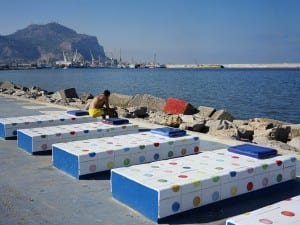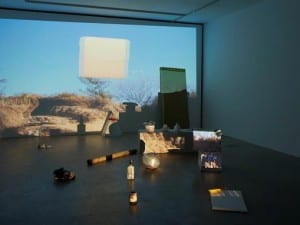The Ronchini Gallery currently boasts the artwork of Adeline De Monseignat and Berndnaut Smilde in The Uncanny exhibition curated by James Putnam. The exhibition embodies the idea of Freud’s concept as well as the juxtaposition of opposing mediums and notions. Drawn together in the works of two differing perceptions, the idea of the uncanny can be aesthetically proven to exist. Aesthetica talks to Adeline for some insight into her art.
A: How has the idea of ‘The Uncanny’ shaped your work?
ADeM: I read Freud’s 1919 essay The Uncanny during my degree. That same year I was assigned the task of writing an essay on my experience of ‘making the familiar strange’. A full day transcribed through the eyes of someone experiencing life for the very first time. However challenging that was, that day was an extraordinary adventure where I consciously learned to rediscover all the things I had long taken for granted – materials, noises, smells, people around me.
Alongside that immersive body and mind experience, the text on The Uncanny opened my eyes on all the oddities of life; the déjà-vu, the ghostly, the doppelganger, the intellectual uncertainty as to whether something is animate or inanimate and so on. At this point, Surrealism was already part of my main influences; I started reading André Breton from a young age and the way in which Surrealists were exploring Absurdity had always felt immensely freeing. I slowly connected the dots and soon after embarked on an MA in Fine Art where I found myself writing a thesis on those themes. It is when curator James Putnam – involved with the Freud Museum – and I started a dialogue on the show for Ronchini Gallery that it all seemed uncannily clear that this would be it.
A: Maybe the most haunting of your installations, are the Creaptures. Can you tell me a little bit more about these?
ADeM: Haunting is the most appropriate of terms. Freud mentions ‘the ghostly’ – from the French word ‘revenant’, meaning that which ‘comes back’ – as being uncanny. In the Creaptures I make I aim for this creepy sense of presence to thrive. I have tested various ways to suggest this potential for a ‘return to life’, one of which was through the material of vintage fur, and more recently through the attribution of human body dimensions to sculptures.
Tradition is that ladies used to commission a fur coat and have their initials embroidered on its lining. Once, I stumbled upon LOLETA; those six letters hinted at the unknown story of its past owner and didn’t fail to give me a sense of that spirit’s presence. I used the coat for a large Creapture, Mother Hairy Eye Ball, who I soon started nicknaming Loleta. I realised the power of titling work. Giving a title to an artwork can often feel cold, distancing and lifeless. Giving a name, however, adds a sense of life and affinity to a piece of work.
I started giving first names to the mirrored Creaptures. Each of them was made in collaboration with someone – artists, philosophers, and even my own mother. They provided me with their birth certificate and they had to get in touch with their own mothers to get hold of the document. Each of them was told something about their first day on earth; wonderful stories. I then made biomorphic handblown glass pieces to match their lengths and weights as newborns. These soon became some sort of an abstract anthropomorphic portrait of each of them. The technique of mirroring, which involved mixing liquid chemicals such as silver nitrate, turned the clear glass into a mirrored surface which would reflect their adult image onto their child selves.
Each creapture was then wrapped in a piece of fabric that refers to a ‘transitional object’. Muslin squares, teddy bears, dolls, blankets are all said to be essential objects for the child to understand the boundaries between his own body and his mother’s. The doll-like aspect of these latter is also relevant. Freud singles out dolls as often being strangely uncanny; inanimate objects that threaten to come to life. Lastly, I hand-stitched the fabric name tags I used to have in my own clothes as a child – a way to ‘leave my mark’.
A: So you said that giving your work a ‘name’ gives it life. Do you feel it also influences the viewer’s interpretation?
ADeM: I have always been conscious of the power of words and the risk of them pinning things down into absolutes. That being said, leaving works untitled runs an even bigger risk of depriving the work of a soul. By giving your work a name, you give it an identity. This is why I am currently using first names for my Creaptures.
A: The creation of the glass and fur works is intriguing. Do you have a vision of what you want to make and then set out to produce it, or does your mind pre-empt certain creative boundaries that you have to work around?
ADeM: Ideas usually come when falling asleep or in the middle of the night. I like to think of the shapes I am obsessed with as ‘generous’. I see them as bodily, bio-morphic, sensual, even sexual; they refer to the body as something that is desirable, to be touched, but also to the body as a fertile creature able to give life.
I always push myself to experiment with something unexplored – welding, glass-blowing, sewing, motor building, filmmaking, etc. – so that I am constantly investigating or discovering. I do encounter technical challenges, but that makes it more interesting.
A: How do you think your compositions work with Berndnaut Smilde’s?
ADeM: Even though both our work is unapologetically bold with a main focalising point, they still hold enough of an eeriness to let the space around play a crucial role. Space and displacement are vital for both our works to breathe properly, and it is also through that that our works connect and communicate.
A: What is the main driving force for your work?
ADeM: Life, testing life, giving life, feeling alive.
Claire Mitchell
The Uncanny, curated by James Putnam, 16 January until 16 February, Ronchini Gallery, 22 Dering Street, Mayfair, London, W1S 1AN. www.ronchinigallery.com
Credits:
1. Adeline de Monseignat, Tantal Eyes, 2012, courtesy the artist and Ronchini Gallery
2. Adeline de Monseignat, Hairy Eye Ball, 2011, courtesy the artist and Ronchini Gallery
3. Adeline de Monseignat, Loleta, 2012, Courtesy the artist and Ronchini Gallery
4. Installation image, The Uncanny Adeline de Monseignat and Berndnaut Smilde, courtesy the artists and Ronchini Gallery, photo Susanne Hakuba





